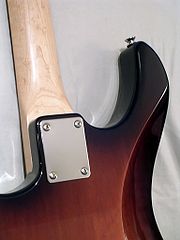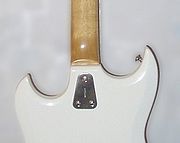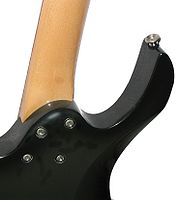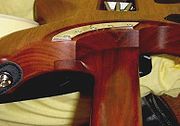
Bolt-on neck
Encyclopedia

Guitar
The guitar is a plucked string instrument, usually played with fingers or a pick. The guitar consists of a body with a rigid neck to which the strings, generally six in number, are attached. Guitars are traditionally constructed of various woods and strung with animal gut or, more recently, with...
(or similar stringed instrument) construction that involves joining a guitar neck and body using screw
Screw
A screw, or bolt, is a type of fastener characterized by a helical ridge, known as an external thread or just thread, wrapped around a cylinder. Some screw threads are designed to mate with a complementary thread, known as an internal thread, often in the form of a nut or an object that has the...
s as opposed to glue as with set-in neck
Set-in neck
Set-in neck is a method of guitar construction that involves joining guitar neck and body with a tightly fitted mortise-and-tenon or dovetail joint, secured using some sort of adhesive...
joints. The term is a misnomer, introduced mostly by Fender whose guitars traditionally had "bolt-on necks". Real bolted joints (i.e. using bolt coupled with a nut
Nut (hardware)
A nut is a type of hardware fastener with a threaded hole. Nuts are almost always used opposite a mating bolt to fasten a stack of parts together. The two partners are kept together by a combination of their threads' friction, a slight stretch of the bolt, and compression of the parts...
) are uncommon in guitar production. However, at least one aftermarket manufacturer offers a replacement for Fender neckplates and screws which uses captive inserts — embedded in the guitar body by means of an external self-tapping thread — and M4 machine screws. This is claimed to permit a higher fastening torque than ordinary woodscrews, and hence a better coupling between neck and body.
This method is used frequently on solid body electric guitar
Electric guitar
An electric guitar is a guitar that uses the principle of direct electromagnetic induction to convert vibrations of its metal strings into electric audio signals. The signal generated by an electric guitar is too weak to drive a loudspeaker, so it is amplified before sending it to a loudspeaker...
s and on acoustic flattop guitars. In the typical electric guitar bolt-on neck joint, the body and neck cross in horizontal plane, the neck is inserted in a pre-routed "pocket" in the body, and they are joined using 4 (rarely 6) screws. As screw heads damage the wood and could put extra stress on it, typically a rectangular metal plate or a pair of metal plates are used to secure the joint and re-distribute the screw pressure evenly. Such a plate is usually criticized for making playing on top frets uncomfortable, so, manufacturers sometimes employ some kind of more intricate method to hide a metal plate, smooth the angles and make access to top frets easier. However, a visible metal plate is usually considered as a part of "vintage" style and they are a popular place to emboss manufacturer's logos, stamp out serial numbers and put other artwork.
The typical acoustic guitar bolt-on neck as popularized by Taylor guitars includes threaded inserts in the heel of the neck. Bolts inserted through the neck block of the body from inside the instrument attach the neck to the body.
Luthiers and guitar players cite both advantages and disadvantages of bolt-on neck construction. Note that most of these views are highly subjective and relative. It is not easy to measure most of the claims objectively or even compare objective factors, as guitars differ considerably.
Bolt-in neck
Some sources differentiate bolt-on and bolt-in neck construction.The difference is that a bolt-on neck involves constructing a protruding flange that fits inside a routed pocket in the guitar body. Then the neck is secured inside this pocket using screws that run perpendicular
Perpendicular
In geometry, two lines or planes are considered perpendicular to each other if they form congruent adjacent angles . The term may be used as a noun or adjective...
(at right angles) to the surface of the guitar. In contrast, a bolt-in neck doesn't need to have such a flange inside the guitar body, and screws or bolts run parallel
Parallel (geometry)
Parallelism is a term in geometry and in everyday life that refers to a property in Euclidean space of two or more lines or planes, or a combination of these. The assumed existence and properties of parallel lines are the basis of Euclid's parallel postulate. Two lines in a plane that do not...
to the surface of guitar, entering the back of the heel.
Usually (but not always), in bolt-in variant, a neck pickup is mounted directly on the extended neck wood underneath it, not on the guitar body. This has been referred to as "direct coupling", because the pickup is mounted on the neck and not the body, in other words, directly coupled to the neck, and is considered superior by some in terms of tone.
Bolt-in neck is used in electric guitars on a regular basis, but on acoustic guitars it is somewhat rare, and harder to produce. However it is considered superior by some in terms of sound and playability. However, given a relative uncommonness of bolt-in necks in electric guitars, most luthiers call both neck joints "bolt-on".
Advantages

- Easier and cheaper to mass produceMass productionMass production is the production of large amounts of standardized products, including and especially on assembly lines...
and repair if damaged. Necks that allow Fender "standard" 4-screw joint are frequently interchangeable provided they are intended for the same style of guitar (e.g. Stratocaster or Telecaster): for example, one can order custom neck (with personal profile or radius) and change one by just removing one neck and attaching the other. A Stratocaster neck can also be fitted to a Telecaster body, although the reverse is untrue unless some minor modifications are made. Less traditional versions exist, such as 3-screw plate (with easier micro-tilt adjustment) or even 6-screw plate bolt-on joint, but they may differ widely in the shapes, sizes and position of screws. Which one is better is debatable, but budget guitar manufacturers often choose 3-screw joints for its minimal cost, notwithstanding the quality. - Easy to control: sometimes bolt-on neck includes some sort of adjustment screw that can control neck-to-body angle, such as the FenderFenderFender Musical Instruments Corporation, commonly referred to as simply Fender, of Scottsdale, Arizona is a manufacturer of stringed instruments and amplifiers, such as solid-body electric guitars, including the Stratocaster and the Telecaster...
Deluxe American Stratocaster's "Micro-Tilt" adjustment. - More attack and "snap", slightly brighter tone, but this advantage is frequently debated.
Disadvantages


- For solid body electric guitars, harder access to top frets, especially if screw plate is used and visible. Slick heel with hidden plate (such as depicted one) makes playing the top frets more comfortable and special neck joint techniques, such as the IbanezIbanezis a Japanese guitar brand owned by Hoshino Gakki. Based in Nagoya, Aichi, Japan, Hoshino Gakki were one of the first Japanese musical instrument companies to gain a significant foothold in import guitar sales in the United States and Europe, as well as the first brand of guitars to mass produce...
AANJ, Music ManMusic Man (company)Music Man is an American guitar, and bass guitar manufacturer. It is a division of the Ernie Ball corporation.-Early years:The Music Man story began in 1971 when Forrest White and Tom Walker talked with Leo Fender about starting a company they would call Tri-Sonic, Inc...
Silhouette and Stephen's Extended Cutaway mitigate this problem. - Less resonance due to minimized contact with body. Gluing or "set-neck" guitars allow for better overall contact between the guitar neck and the body.
- Sloppy construction or assembly of a bolt-on guitar exacerbates any of its inherent disadvantages.
Manufacturers
Notable manufacturers of guitars with bolt-on necks include:- Fender, a company known for its dedication to bolt-on neck construction.
- Music ManMusic Man (company)Music Man is an American guitar, and bass guitar manufacturer. It is a division of the Ernie Ball corporation.-Early years:The Music Man story began in 1971 when Forrest White and Tom Walker talked with Leo Fender about starting a company they would call Tri-Sonic, Inc...
. - IbanezIbanezis a Japanese guitar brand owned by Hoshino Gakki. Based in Nagoya, Aichi, Japan, Hoshino Gakki were one of the first Japanese musical instrument companies to gain a significant foothold in import guitar sales in the United States and Europe, as well as the first brand of guitars to mass produce...
- CarvinCarvinThis article refers to a French commune. For the guitar manufacturer see Carvin Corporation. For the late New Orleans political consultant see Jim Carvin.Carvin is a commune in the Pas-de-Calais department in the Nord-Pas-de-Calais region of France....
www.carvinguitars.com - ESP GuitarsESP Guitars, located in North Hollywood, California, is an American-based, Japanese-owned manufacturer of electric guitars and basses.- History :In 1975, Hisatake Shibuya opened a shop called Electric Sound Products in Tokyo. It provided custom replacement parts for guitars. In 1976, ESP gained a reputation...
uses a 3-bolt plate with a contoured heel for better fret access. - Taylor GuitarsTaylor GuitarsTaylor Guitars is an El Cajon, California‐based luthier, specializing in acoustic guitars, as well as semi-hollow and solidbody electric guitars. It was established in 1974 by Bob Taylor and Kurt Listug.- History :...
is known as a manufacturer of acoustic guitars, though they use special patented bolt-in construction process with 3 bolts. Two steel bolts pass horizontally through the body and into the neck, and a third bolt passes vertically into the fingerboard extension. - Seagull, an acoustic guitar brand manufactured by Canadian company Godin Guitars.
- JacksonJackson Guitars__FORCETOC__Jackson is a renowned brand of electric guitar that bears the name of its founder, Grover Jackson.-Early years:Grover Jackson obtained ownership in Charvel's Guitar Repair of Glendora, California in the 1970s with a promise to bolster Charvel's business...
, a well known electric guitar manufacturer that is currently a subsidiary of Fender mentioned above. - Walden GuitarsWalden GuitarsWalden Guitars is a manufacturer of acoustic guitars and classical guitars. Walden Guitars are built in the small town of Lilan, nearby Langfang, China. Formed in 1996, Walden Guitars is a collaboration between CFox Guitars, Inc. luthiers Charles Fox and Jonathan Lee, and Taiwan instrument...
, one of the first Asian acoustic guitar brands to incorporate a bolt-on heel / glued down fingerboard extension.

